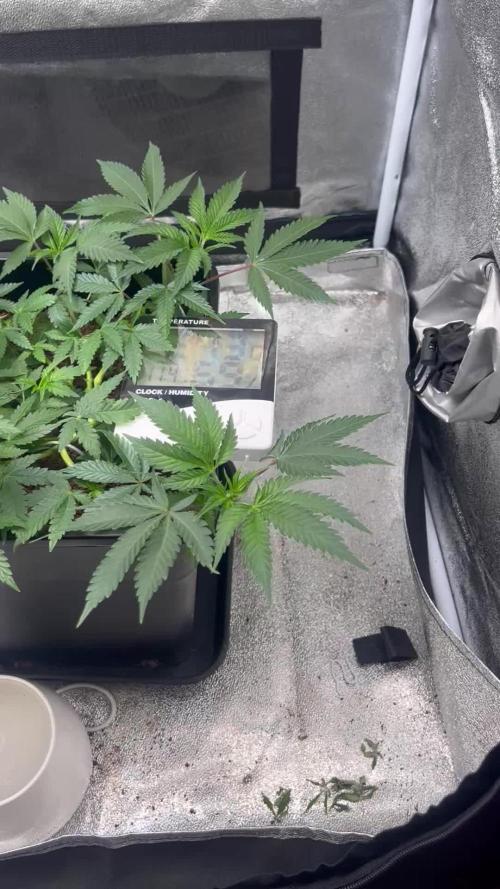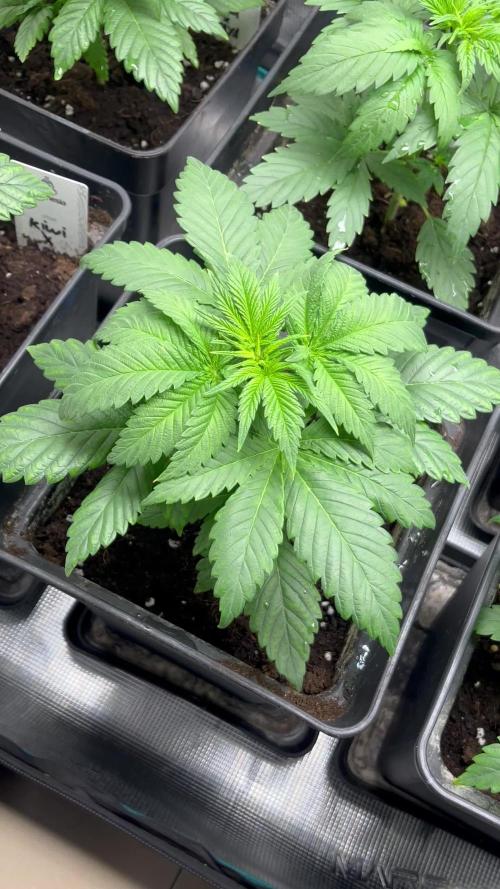The Grow Awards 2026 🏆 


























Likes
Comments
Share


@Ultraviolet
Follow
I gave Isopropyl alcohol 70% equal parts water, 1 tsp cayenne, and kept enough for multiday application, what little population of aphids is left I shall catch them the next morning, opening the tent 10 min before lights on the clovers have yet to open, all the aphids hiding on the undersides are easily visible, still none ever went near cannabis plant. Clovers are far tastier it seems.
The alcohol kills on contact, the idea was to saturate the leaves with a light foliar application, and once I was done I ran it through the canopy with my hands, making sure as much of the clover surface came in contact with the iso, once done, I turned on the fans and evaporated it quickly. The beautiful thing about Isopropyl is that it evaporates rapidly at room temperature, way below boiling point leaving behind zero residual so nothing seeps its way into root zones unless you spill it there.
It is a magical solvent that leaves no trace that it was ever there.
Resonant Frequency:
A resonant frequency is the natural vibrating frequency of an object and is denoted as ‘f’ with a subscript zero (f0). When an object is in equilibrium with acting forces and can keep vibrating for a long time under perfect conditions, this phenomenon is resonance.
In our daily life example of a resonant frequency is a pendulum. If we pull back the pendulum and leave, it will swing out and return at its resonant frequency. Objects combine to form a system, this system can have more than one resonance frequency. The resonant frequency is termed as the resonance frequency.
The phenomena of resonant frequency used in the series circuit when the inductive reactance (XL) is equal to the capacitive reactance (XC). If the value of supply frequency is changed, we can observe that the value inductive reactance (XL) and capacitive reactance (XC) is also changed.
Inductive reactance (XL) and capacitive reactance (XC) are inversely proportional to each other. When we increase the frequency, the value of XL increases, whereas the value of XC decreases. When we decrease the frequency, the value of XL decreases whereas the value of XC increases.
At series resonance, when XL = XC. The mathematical equation of resonant frequency is:
XL = 2πfL; XC = 1/2πfC
XL = XC
2π f0L = 1/ 2πf0C ; f0=1/2π sqrt{LC}
Where f0 is the resonant frequency, L is the inductance, C is the capacitance
How to Calculate the Resonant Frequency of an Object?
An object exposed to its resonant frequency can vibrate in symphony with the sound. The wavefronts pushing on the object will arrive at just the right time to push the object with greater and greater amplitude in each cycle.
To get a clear idea of this concept one of the best examples is pushing a friend on a swing. If you push the swing randomly, the swing will not move very well but if you push the swing at a specific time, the swing will get higher and higher.
Another example to find the resonant frequencies is to place the object next to a speaker and place a microphone attached to an oscilloscope next to the object. Then play the sound in the speaker at a given volume, and then without changing the volume slowly change the frequency.
Now observe the oscilloscope, you will observe that at certain frequencies the amplitude of the wave, is proportional to the volume of the sound that the microphone is able to pick up.
The frequency that is caught by the microphone will be greater than at surrounding frequencies. These are the resonant frequencies and are detectable as the sound energy absorbed by the object is re-emitted more efficiently at these frequencies. The precise moment that constructive interference happens the amplitude of the wave will spike at the precise frequency emitted.
Q: Compute the resonant frequency of a circuit whose inductance is 25mH and capacitance is 5mu F?
A: Known values are,
L = 25mH = 25 x 10-3 H
C = 5mu F = 5 x 10-6 F
Formula for resonant frequency is,
f0= 1/2π sqrt{LC}1/2π√L
f0=1/2 ͯ 3.14√ (25 ͯ 10-3 ͯ 5 ͯ 10-6)
= 450.384Hz
Why Neodymium?
Ferromagnetism is an exciting phenomenon observed in certain materials, known as ferromagnetic materials, that can retain their magnetization even after removing an external magnetic field. Ferromagnetic materials can become ferromagnets and interact strongly with other magnets and magnetic fields. A characteristic of ferromagnetic materials is their magnetization ability, distinguishing them from paramagnetic and diamagnetic materials, where weak magnetism exists temporarily.
This unique property allows for making permanent magnets widely used in various applications such as motors, generators, speakers, and data storage devices. The ability to generate and maintain a magnetic field without the need for a constant external source of power makes ferromagnets highly valuable.
An alloy of neodymium, iron, and boron discovered in the 1980s is ferromagnetic, yielding permanent magnets over 1000 times stronger than anything ever seen before.
The name neodymium comes from the Greek neos didumous, which means "new twin."
Neodymium magnets are made of an alloy of neodymium, boron, and iron. This allows them to simultaneously store impressive amounts of magnetic energy while being highly resistant to demagnetization.
Because iron oxidizes quickly, neodymium magnets are coated to prevent rust from accumulating.
The attraction between two neodymium magnets is so strong that if placed close enough together, they can collide and shatter.
Neodymium magnets have an unusually high-temperature resistance, and they can even withstand heat exceeding 200 degrees Celsius.
N50UH 1-1/2"OD x 1.065"ID x 3/8"
Likes
37
Share


@RFarm21
Follow
Foram regadas no dia 11/07/2021, 3 plantas com um total de 5L . E.C 0,43.
A R.Gorilla 2 foi regada com 1,5L e foi a primeira vez que foi alimentada. E.C 0,16 / pH 6.2
R.Juice - 2ml ; Bio Heaven - 1ml ; Activera - 0,5ml ; calmag - 0,2 ml ;
Ansioso para ver os resultados do LST, na royal gorilla 2 ( a mais pequena ) irei fazer o lst mais cedo e tentar não dobrar tanto o caule junto ao solo para ver as diferenças.
Será que fiz bem?
Likes
27
Share


@ButterfliesLittleFarm
Follow
Hello Diary.
Finished and the third week of flowering, Haze Berry looks really impressive. Tall and stocky :). 😎
The flowers apparently bloom and begin to cover entire branches. The smell is not as intense as that of his roommate Fat Banana, but on my small farm there is a real fruit fantasy. 😋
In the Growbox to his left is his brother, another Haze Berry who is a little late but by all accounts will not catch up with his big brother.
Watering is approximately every three days when I prepare 7 liters of water and with that amount evenly water all three plants. I preventively add CalMg and add BioBizz every other time.
Here’s what he looked like all week.
02/11/2020 - Day 39.
Watering. I added BioBizz and prevention CalMg. p.H. I adjusted to 6.5 with Plagron’s Lemon Kick.
Temp / Humidity on the farm - 26.7 degrees and 42% humidity.
05/11/2020 - Day 42.
Photographing and watering. This time I just regulated p.H. at 6.4 and I didn’t add anything else. The plants look really beautiful so I took photos on a black background at the beginning of flowering.
Temp / Humidity on the farm - 25.6 degrees and 41% humidity.
For now, everything is going great, the plants look happy and I look forward to following further development. See you soon.
Likes
19
Share


@SirBudAlotts
Follow
Hello World 🌎 ☺️ 🤗!!!
She sprouted successfully in her Jiffy Pellet..
Added nothing to the H20...Plain Water!
After she was about 2cm, I transferred her directly into her final home...which is a 15L Fabric Pot filled with Living Soil...Since she will be growing outdoors..
After the transfer..
Gave her a good feeding of plain H20 but made sure not to drown her though..
Likes
4
Share


@Cukito
Follow
Everything doing just as should be. I'll put the scrog screen as soon as I can go to the growshop!! I will put her to flower in two weeks!! (I hope)
Likes
12
Share

Likes
10
Share


@Northern_Ent
Follow
July 14: the double skunk seems to be going well with one plant now on track to circle the rim of the pot nicely.
July 15: single skunk wasn’t doing much so I don’t want to top it and slow it down further. So, I just tied it down instead.
Likes
13
Share


@GYOweed
Follow
This is Week 3 of flower.
It looks like I am going to be the only one between the pest infectors and the bad growers that will have a normal quality harvest.
Smells amazing minty pine.
Very trainwreck sativa structure.
Internodes everywhere.
Small fan leaves.
Likes
5
Share


@Mrg7667
Follow
Smells like Rubber bands coated in a berry sugar or berry sryup very interesting on the nose!
Harvested day 67 ish maybe a couple more hard ot tell outdoor Split the harvest into drying buds and some to made into fresh frozen hash. i can dry weigh the fresh frozen buds and put that weight in the wet section and i will put the to smoke buds in the dry weight section so total between the two will be the whole plant
Drying was a big mishap got condensation around day 10 of drying and it caused some mold 🤦♂️ right around the time i was going to cure!
Found a peroxide soak that ill post butt it seemed to take off all the mold without affecting tricomb heads! Had to re dry for another week afterward i feel like the re dry maybe messed with the terps because it definitely never got the smell back like i thought but who knows slmost 3 weeks into cure coukd get better but doubt it
Likes
19
Share


@Maryjane23
Follow
Hi guys!!!
we're doing pretty well now the buds swell day by day ...
i am giving fertilizer once a week
specifically this week in 1 L of water I put:
co2 ¼ of tablet
enzymes 1.5 ml
candy 3 ml
top bud 1 ml
i am keeping a ph of 6.3 / 6.5
are you curious to try the LEDs but you don't have enough information?
I found the ideal solution with this VIPARSPECTRA XS2000 lamp.
this well-known brand offers different solutions look at the official website https://viparspectra.eu/
or Search for it on Amazon:
Amazon US: https://amzn.to/30xSTVq
Amazon Canada: https://amzn.to/38udUVe
Viparspectra UE: bit.ly/ViparspectraUE
Viparspectra USA: bit.ly/ViparspectraUS
keep following me 😝
if you like my work leave a like and/or comment 👍
maryjane23 👻
Likes
4
Share


@GrowPassionItalyChris
Follow
4 settimane di fase vegetativa sono abbastanza, hanno sviluppato rapidamente circa cinque internodi e le diramazioni sono ormai iniziate, molto compatte e diramate si intuisce che saranno ottimali nel risultato finale. Da domani iniziamo la fioritura a 12 ore di luce, ovviamente prima faranno 24 ore di fila di buio. Nonostante la temperatura un po' fresca a luce spenta comunque crescono rapidamente e con vigore.
Likes
Comments
Share


@eldruida_lamota
Follow
Que pasa familia, vamos con la cuarta semana de crecimiento de estas Kiwi x Papaya feminizadas de Mavericks .
Vamos al lío ,se trasplantaron en macetas de 7 litros definitivamente.
El ph se controla en 6.0 , la temperatura la tenemos entre 24/20 grados y la humedad ronda el 50%.
El ciclo de crecimiento puse 16h de luz, el foco está al 50% de potencia.
De momento van creciendo a buen ritmo y tienen un buen color, estaban muy bien enraizadas al realizarle el trasplante se notaba la abundancia radicular.
Gracias a Agrobeta de nuevo por el kit para esta temporada, unos grandes 🙌.
- os dejo por aquí un CÓDIGO: Eldruida
Descuento para la tienda de MARS HYDRO.
https://www.mars-hydro.com
Hasta aquí todo, Buenos humos 💨💨💨
Likes
12
Share


@DrGreenbutterThumb
Follow
I'm happy with the wet weight given it was 2 plants 11 inches in height when I started, the smells the colors the yield this was an easy and beautiful process
Likes
13
Share


@GERGrowDesigns
Follow
Welcome to Flower Week 3 of Divine Seeds Divine Rapier
I'm excited to share my grow journey with you from my
Sensi Seeds Project . It's going to be an incredible ride, full of learning, growing, and connecting with fellow growers from all around the world!
For this Project , I’ve chosen the Feminized Photo Strain Divine Rapier:
Here’s what I’m working with:
• 🌱 Tent: 120x60x80
• 🧑🌾 Breeder Company: Divine Seeds
• 💧Strain Info : 29%
• ⏳ Flowering Time: 6-7weeks































